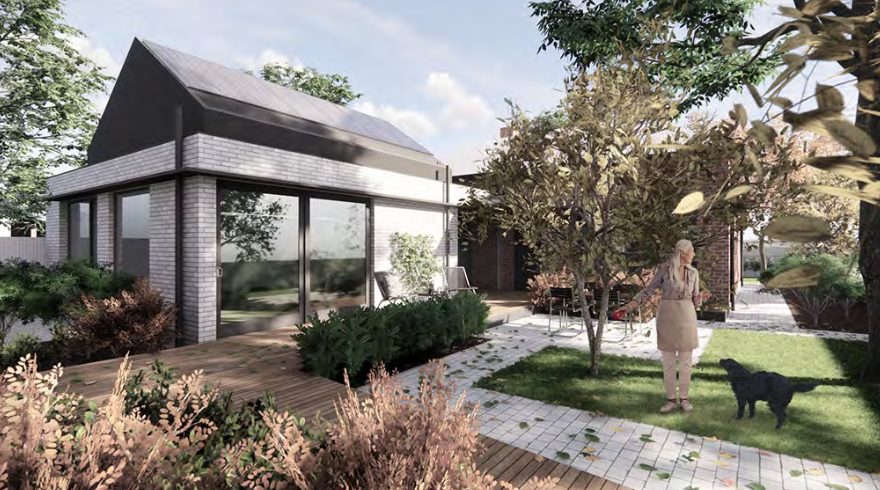City
City of Unley
Main actors
City Government, Community / Citizen Group, Research Institutes / Universities
Project area
Whole City/Administrative Region
Duration
2019 - 2020
A collaborative housing model to assist older people to stay living in their communities.
The City of Unley’s population is ageing and many older people have limited options to downsize and stay in their community when their physical, financial and social needs change. Urban infill* can increase dwelling density but is not always age-friendly and can have detrimental social and environmental impacts.
The project used community co-design principles with older residents to inform new co-housing options. These were designed to retain street character for social cohesion, maintain deep rootzone and garden space for health and climate benefits and provide accessible co-housing with shared amenities to enhance resident’s interaction.
*In urban planning, infill usually refers to the repurposing of land in an urban environment for new construction.
Guangzhou Award
This project was shortlisted for the 'Guangzhou Award' in 2020.
From the latest Australian census data, 22.6% of the City of Unley’s population is aged 60 and above. This trend is predicted to increase, with the population of South Australia (where the City of Unley is located) ageing faster than the rest of Australia. By 2031, there will be more than 1 in 5 of South Australia’s total population.
Objectives
The goals of the project were broad and cross sector including:
- Raising State and Local government awareness of new infill strategies in urban areas that would enable ageing in place and provide environmental benefits.
- Advocating for change in the State Planning and Design Codes that would enable local Councils to approve designs that redevelop existing character housing stock to provide 2 or 3 for 1 infill models.
The Initiative took the innovative ‘Alternative Infill’ housing model and the international principles of co-housing and applied local co-design with older residents to innovate and adapt for local culture and needs. Exploring what shared amenities were desirable and the spatial budgeting priorities of the older community created a new “co-housing Lite” to meet the needs of an urban Australian population. Applying accessibility and livability standards created a new quality of dwelling not currently included in urban planning policy.
The project developed a unique ‘spatial budgeting’ codesign workshop process to engage older residents in its conceptualisation. Mirroring a financial budgeting exercise, residents were given a map with 50m2 for a private dwelling and another 50m2 for communal space. Participants were then given cut-outs of living spaces at various sizes (eg: large, medium or small bedroom, large, medium or small kitchen, etc) and were tasked with choosing how they would tailor their downsized living spaces based on the available space
Real life dwellings were used as exemplars for the redesign process. Older residents from the local council area attended an interactive workshop where they were tasked with individually identifying the degrees of sharing, they could imagine living with, and those that would be barriers or outright ‘deal breakers. Draft designs were prepared to illustrate to example co-housing models for two different site sizes and residents determined the spatial budgeting and priorities for their needs.
Embedding outcomes in the planning and design regulations will enable co-housing to pass local planning approvals in the future. Ongoing work is planned to create design guides for architects, training for local planners in assessment of cohousing designs and governance structures for residents to ensure successful site redevelopment long term.
The lead agency for the project was the City of Unley who provided project management and local planning expertise alongside other local government agencies who collaborate with the public State Planning Commission and Department of Infrastructure. Coincidently, both institutions were undertaking a project to consolidate current local planning codes into a single state-wide policy. Thus, research in action directly affected new policy. Innovative public- community partnerships supported this by using older residents to codesign cohousing with our partner in design expertise the University of South Australia.
Council provided project support and administration, exemplar design sites, and professional expertise on current planning approval and process. The State commission provided input regarding the new code development. Specific design expertise was provided by the faculty of Architecture at the University of South Australia.
The project was successful in achieving a change in attitude towards co-housing and an appreciation of the benefits it can bring to all ages but specifically older individuals. The attitude change was across the public community, local government and State Australian government departments.
Outcomes included a suite of innovative cohousing designs sympathetic to local housing styles yet designed to promote ageing in place. A submission was made to the State Government to propose new planning codes that could facilitate the transfer of these new cohousing concepts into reality.
A submission to the new State Planning and Design code to facilitate well designed infill aligning to the projects defined cohousing principles has been achieved, and if successful will have an initial State-wide significance and is likely to raise interest nationally
Older individuals wishing to age in place in their community often find limited options to downsize when their housing no longer suits their needs or when they wish to avoid living alone. The urban infill favoured by developers whilst increasing dwelling density is not necessarily age-friendly and has significant negative impacts on streetscape, environment and community spirit.
Resistance was encountered in the community to the concept of co-housing based on a lack of exposure to this form of social housing in Australia. The co-design workshop allowed participants to explore what individual and amenities they would feel comfortable to share with resulting in a new form of co-housing suited to the Australian culture.
Conceptual planning obstacles were encountered early on by the design not fitting the established planning and design codes. Developing a full suite of designs supported by technical drawings allowed planning professionals to consider new legislation that could allow such beneficial co-housing to be built.
Australian cities are struggling with the challenge of providing increased infill housing numbers and diversity for older people in suburbs well-connected to government, health, recreational, commercial and civic services, without the destruction of existing neighbourhood character. This phenomenon has been widely described (refer Australian Housing and Urban Research Institute). The Cohousing for Ageing Well project is a direct response to AHURI’s data, which indicates that housing options that allow residents to age within their community is desired by residents.
Shared learnings include the benefit of cross public- community partnership, the value of cross disciplinary experts and the vital insights of older residents to the design process.
By bringing all the parties together a new concept of co-housing was established which challenged public stereotypes about sharing space, met the cultural expectations of the community, aligned with the principles as established overseas and met the pragmatic requirements of both local council and State planning process. Rigour was ensured by the involvement of University experts and creativity was boosted by engaging with architects that could challenge the dwellings usually designed for older adults.
The design report and submission documents to our local Planning and Design code along with the methodology for the co-design workshop are available for other cities to utilise to engage with their residents to explore new cohousing options
The designs, if embedded in code, will be Australian State based - therefore covering all local governments and suburbs.
On Map
The Map will be displayed after accepting cookie policy

